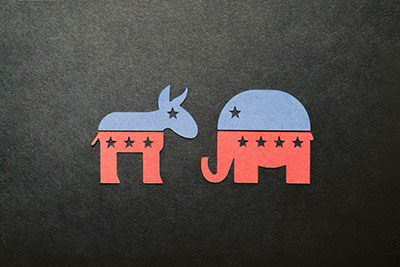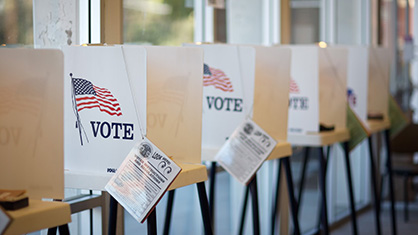Parties, Partisanship and Cooperation
Interventions to Reduce Partisan Animosity

Partisanship and Voters' Perceptions of Campaign Promises
How do voters’ political loyalties affect their view of how well politicians keep their campaign promises? In a working paper, IPR political scientist Tabitha Bonilla seeks to answer this question through two studies. In the first study, in 2019, she surveyed 547 U.S. adults, 237 Democrats and 140 Republicans, about a political candidate of their own or of the other political party, who kept their promise, broke their promise, or were unsuccessful in keeping their promise, about the highly partisan issue of immigration. Respondents were asked about their overall opinion of the candidate and how successful they found the candidate. Results revealed that respondents of both parties viewed a candidate’s success in keeping campaign promises according to the candidate’s political party. Generally, candidates of the other party seemed to be rated more for their political beliefs than for their promise keeping. In study two, in 2020, Bonilla posed a similar question to 2,303 people, with two new factors: A candidate might have no party affiliation, and respondents were asked either about immigration or human trafficking, a bipartisan issue. As in the first study, candidates of their own party were rated far more favorably than those in the other party. However, for the non-partisan issue of human trafficking, all candidates were rated similarly. Bonilla’s investigation demonstrates that voter perception of political promise fulfillment is heavily influenced by partisan beliefs when the issue is a partisan one, especially if it is unclear whether the promise was kept.
The Challenge of Balancing Primary and General Electorates
The U.S. two-stage election process presents a challenge for legislators—should they appeal to their primary electorate or the general electorate when the two conflict over policy issues? In a working paper, IPR political scientist Laurel Harbridge-Yong and her colleagues explore whether legislators have more incentives to appeal  to primary voters over general election voters. They analyzed public opinion data from the 2016 Cooperative Election Study, looking at the policy positions of over 64,000 Americans who voted in either the primary or general election. They find that when the primary and general electorates were on opposite sides of an issue, the primary electorate was more unified in their preferences in 73% of the cases. In a survey experiment looking at how 13,000 respondents evaluated hypothetical incumbents and their challengers, they find that when incumbents aligned with voters on three policy issues, the incumbent had a greater chance of winning. This effect was substantially larger in a primary election versus a general election. The results suggest that legislators have greater incentives to align with the policy preferences of primary voters, which they call the “primary premium,” because voters are more unified and are more likely to care how their legislator votes. Because appealing to primary voters may lead to polarization and alter dynamics of representation, the researchers argue it is important to understand the tensions between primary and general electorates.
to primary voters over general election voters. They analyzed public opinion data from the 2016 Cooperative Election Study, looking at the policy positions of over 64,000 Americans who voted in either the primary or general election. They find that when the primary and general electorates were on opposite sides of an issue, the primary electorate was more unified in their preferences in 73% of the cases. In a survey experiment looking at how 13,000 respondents evaluated hypothetical incumbents and their challengers, they find that when incumbents aligned with voters on three policy issues, the incumbent had a greater chance of winning. This effect was substantially larger in a primary election versus a general election. The results suggest that legislators have greater incentives to align with the policy preferences of primary voters, which they call the “primary premium,” because voters are more unified and are more likely to care how their legislator votes. Because appealing to primary voters may lead to polarization and alter dynamics of representation, the researchers argue it is important to understand the tensions between primary and general electorates.
Top-Four Primaries Help Moderate Candidates Via Crossover Voting
Highly partisan voters tend to dominate U.S. primary elections, making it difficult for moderate candidates to intellections and leading to efforts to reform the electoral process. The electoral challenges that moderates face are important because moderate candidates might represent a broader swath of the electorate than the ideological partisans often favored in primaries. In The Forum, IPR political scientist Laurel Harbridge-Yong and her colleagues study reforms put in place for the 2022 Alaska election to assess whether a top-four primary, where all candidates are listed on the ballot and voters can pick regardless of the candidate's party affiliation, enhances moderate candidates’ chances of winning both the primary and general elections. The researchers asked six experts to identity the most moderate candidates in Alaska’s 2022 primary elections for statewide and state legislative races. They compared how successful these moderate candidates were under Alaska’s top-four primary to a hypothetical partisan primary with the same set of candidates and voters. They did this to understand whether moderates who would have lost in the old primary system go on to win the general election under the new election system. They also examine whether top-four primaries bring out more moderate voters to the polls compared to the old partisan primary system and whether the ability to vote for different parties increased crossover voting. They find that the top-four primary in 2022 likely benefited moderate candidates, especially in the scenarios where only candidates from one party ran in the primary. They calculate that at least two moderate candidates, who would have lost in the old system, emerged from the top-four primary and won the general election under the new system. More undecided voters participated in 2022 compared to the previous partisan primary in 2020, which suggests that the reform opens opportunities for more participation. And opportunities for crossover voting allowed voters from the other party to support the moderate candidate, such as in the race for U.S. senator where crossover Democratic voters helped Republican Lisa Murkowski perform better than Democratic candidates and her co-partisan rival. The results provide suggestive evidence that top-four elections can increase moderate candidates’ chances of winning.